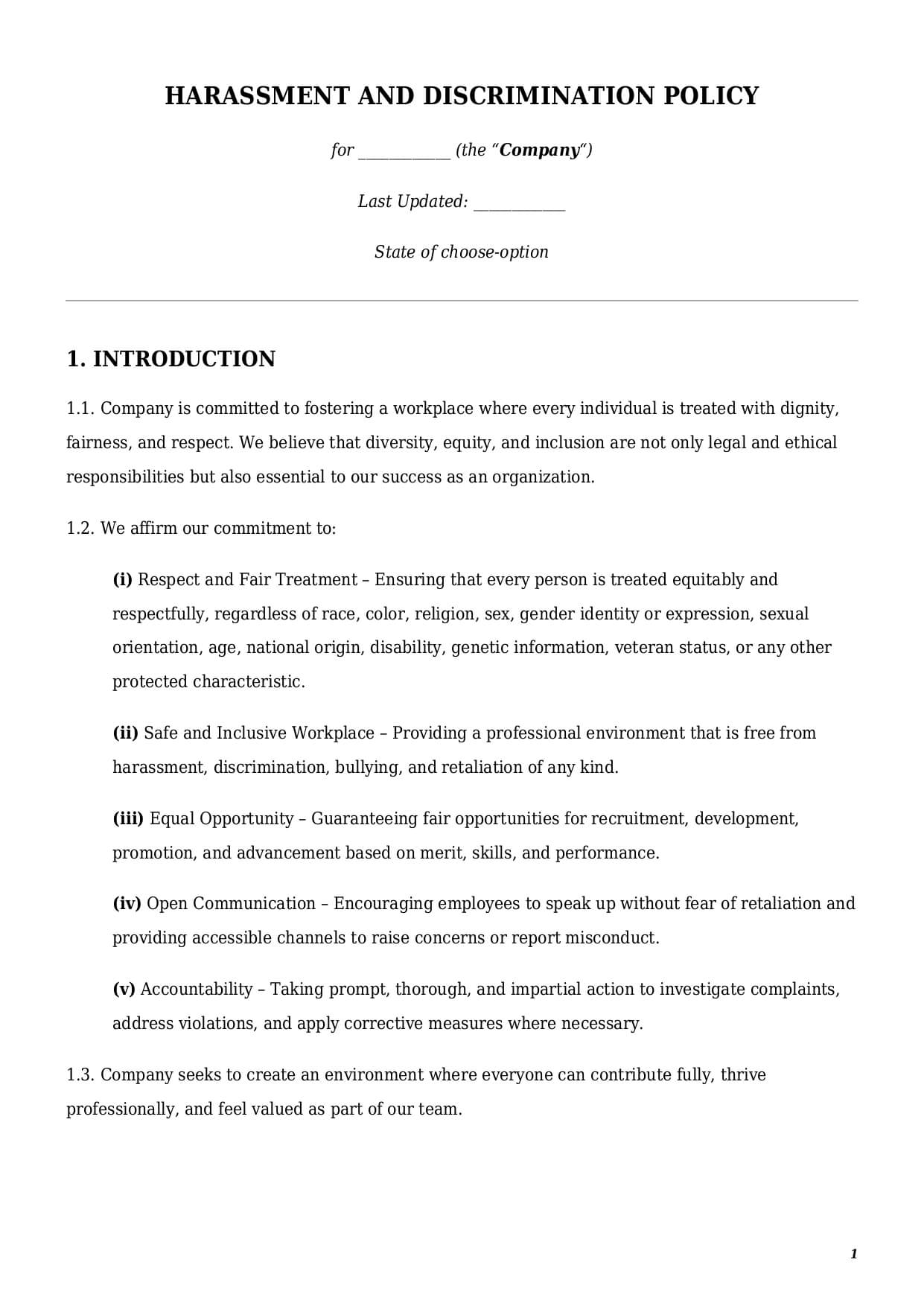Harassment and Discrimination Policy
Reviews


What is a Harassment and Discrimination Policy Template?
A harassment and discrimination policy template is an internal corporate document that clarifies the procedure in preventing, addressing, and resolving cases of workplace discrimination and harassment. It outlines the standards of behavior expected within the workplace, as well as other important information:
- parties involved (i.e., name of organization, categories of employees to whom the policy shall apply);
- list of non-acceptable behavior at the workplace;
- incident reporting procedure, including timelines and responsible parties;
- employees’ duties and responsibilities at the workplace; and
- confidentiality of investigation, etc.
This policy could be helpful across various industries, to companies and businesses of different sizes, and to nonprofit and for-profit organizations. Having a solid bullying and harassment policy template is a must-have for two important reasons:
- First, to comply with existing federal and state laws;
- Second, to combat cases of harassment or discrimination at the workplace; and
- Third, to ensure a safe and inclusive environment for everyone at the workplace, despite their gender, sex, race, origin, and other characteristics, etc.
This policy could be used in conjunction with other similar documents, including the employee handbook, remote working policy, social media policy, etc.
How to draft a harassment and anti-discrimination policy template?
Drafting an effective harassment and anti-discrimination policy template requires attention to detail, as well as the inclusion of a number of important elements. Without certain components a policy cannot become a complete and practically enforceable document. Below we made a summary of the most important chapters you have to include in your organization’s policy dealing with harassment and discrimination:
Scope of Policy Application
Every discrimination policy template defines who shall be covered by the policy. Therefore, it is better to avoid inclusion of general wording like ‘all employees‘ or ‘employees working at the company.’ The best way to define the policy’s scope of application is to list all categories of employees that should be covered, for instance:
- part-time, full-time, or both;
- employees who work based on a permanent or temporary employment contract;
- volunteers and interns; or
- contractors and workers with existing service agreements, etc.
It is vital to understand that the company’s internal policy dealing with harassment and organization could apply only at the workplace. In other words, an organization or business cannot apply their policy towards other third parties like customers or clients. This is so because a workplace harassment policy template is focused on managing the behavior of individuals who have contractual relations with the organization.
Definition of Harassment and Discrimination
For the policy to be applied effectively, employees must clearly understand which behaviors are acceptable and which are not. Establishing clear rules makes it easier to address inappropriate conduct and helps maintain a healthy, respectful, and professional workplace environment.
With that in mind, every nondiscrimination policy template shall specifically explain which behavior could be treated as harassment and which as discrimination.
The best way to do that is to list in the text of the policy all possible examples of unwelcome behavior at the workplace. In most cases, organizations and businesses do not allow the following:
- offensive jokes, comments about someone’s background;
- spreading rumors about other colleagues;
- prohibition of discriminative practices (e.g., refusal of promotion based on the race or gender), etc.
To make sure that employees are well aware of limitations, some workplace harassment policy templates suggest the conduction of regular training for the organization’s staff. The trainings may take place on-site or outside of the workplace and aim to increase employees’ knowledge about unsolicited discrimination and harassment.
Incident Investigation
Incident investigation is a core element of every discrimination and anti-harassment policy template. This chapter defines the process for reporting, investigating, and resolving incidents.
A well-drafted policy template shall address the following components:
- Reporting procedure: Every bullying and harassment policy template lays out available options for sending the incident report. Those options may include reporting in person, sending official communication via email, etc.
- Authorized person: This is a person who is in charge of investigating a discrimination or harassment report. Usually it is a compliance manager or someone from the internal Human Resource Department authorized to deal with complaints. However, it is also common for small businesses to engage an independent third party to deal with incident reporting and resolution.
- Timeline: Defining the exact timeline within which a complaint shall be investigated is key for every good anti-discrimination policy template. Usually it should be a short period of time. However, depending on the complexity of the case, the investigation can take from a few days to a few months.
- Consequences: The policy should clearly outline the specific consequences that will apply to any individual who commits an offense. The consequences may have various forms, including temporary suspension from position, written warning, refusal of promotion, or termination of employment relations.
Publishing the Policy
Unlike a standard contract, which becomes effective once signed by both parties, a policy does not require mutual execution to take effect. A harassment and discrimination policy template can only become effective if employees are aware of it. There are a number of ways your organization or business could announce the present policy to its employees:
- First, by printing out the text of the policy and making everyone in your organization sign it. Though, it is a less effective way to do that.
- Second, by sending a personalized email to every employee with the attached policy in it. Once an employee receives such an email, it means they acknowledge the existence of the policy.
- Finally, by publishing the text of the policy on the organization’s website or intranet.
If at any time you need to change or update the text of the policy, you have to notify your employees the same way.
How to customize a policy template at Faster Draft?
To get a fully customized harassment policy template, follow a few easy steps below:
- Click the button “Create Document.”
- Answer simple questions in the form.
- Select a document’s template—Discrimination Policy Template PDF or Word.
- Make a payment.
- Download and use a ready-made customized policy for your business or organization.
Table of content
Frequently Asked Questions (FAQ)
-
1. What shall I include in the California harassment policy template?
State legislation in California is much more robust and detailed when it comes to discrimination, bullying, and harassment compared to other U.S. states. Same as policies for other states, the California harassment policy template shall always include the scope of application, detailed investigation process and timelines, policy’s amendment rules, etc.
At the same time, policy templates for organizations and businesses operating in California should include:
- prohibition of discrimination by virtue of immigration status, hairstyle, or military or veteran status; and
- mandatory harassment prevention trainings for employees at least once every two years.
This does not mean that other states cannot include similar additional requirements in their workplace policies. However, the components listed above represent the mandatory minimum standard in California.
-
2. What is the difference between this policy and the sexual harassment policy template?
The present document is focused on a broader number of cases that may occur in the workplace, including:
- discrimination based on various protective characteristics (e.g., race, gender, sex, nationality, citizenship, military status, etc.); and
- harassment at the workplace (e.g., verbal abuse, bullying, retaliation, sabotage of work).
A sexual harassment policy template is focused specifically on prohibiting cases of sexual harassment and has a much narrower application compared to the present policy. Sexual harassment cases at the workplace may include sexual jokes, unsolicited compliments, etc.

Looking for something Different?
Start typing to find out our collection of legal documents and contract templates
